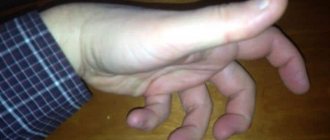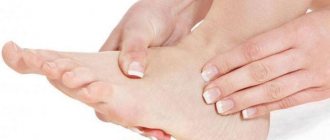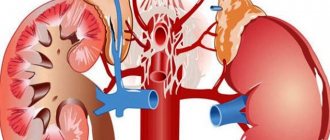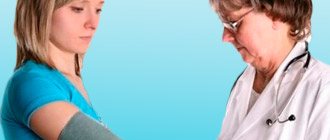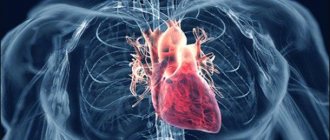The veins in the arms hurt – a symptom of the onset of a pathology that forms in the vascular tissue. There are different causes of the condition that a phlebologist identifies. He prescribes diagnostic tests and laboratory research methods, after which treatment begins.
How long have you had this pain syndrome?
- Several days (26%, 976)
- First day (21%, 798 Votes)
- Several months (12%, 452)
- Week (10%, 376)
- Several weeks (10%, 358)
- About a month (8%, 312)
- Chronic form (6%, 236)
- About a year (6%, 210)
Total voters: 3 719
Loading …
Use search Are you having a problem? Enter “Symptom” or “Name of the disease” into the form, press Enter and you will find out all the treatment for this problem or disease.
Why do the veins in my arms hurt?
Factors causing the painful syndrome:
- Compression, spasm. Blood circulates more slowly and carbon dioxide is transported at a low rate.
- Thrombosis. A blood clotting disorder leading to increased formation of blood clots (small, large). Even the smallest veins clog the veins on the arms, as they are thin.
- Phlebeurysm. More often it starts on the legs. When the condition is advanced, it spreads to the hands and forearms. Varicose veins cause a chronic disease and are difficult to eliminate.
- Thrombophlebitis. The inflammatory state of the endothelium is accompanied by the deposition of thrombotic masses. If they come off, they will block the lumen.
- The effect of cold. If a person is in the cold, vascular spasms occur. The condition goes away when the limbs and skin warm up.
- The formation of benign and malignant neoplasms that interfere with normal blood circulation.
- Systemic diseases causing vascular damage. For example, diabetes mellitus, atherosclerosis. The endothelium becomes brittle and hematomas appear.
Research is being carried out to find out the reason. Angiography is used with the addition of a contrast agent. On the monitor, the doctor sees areas of damage. Laboratory tests are carried out to determine the state of the coagulation system and platelets.
ethnoscience
Non-traditional methods can also be used as an addition to the main methods and only with the permission of the attending physician. For each patient, treatment must be selected individually. What helped one person may be completely useless for another, and even harm a third.
- Perhaps the oldest method is treatment with leeches. These creatures, in the process of sucking blood, release a special substance into the circulatory system that has a thinning effect on the blood. Nowadays, pharmacologists produce many drugs with similar effects, but some patients do not tolerate such medications well. It is for such people that treatment with leeches may be the best way.
- Treatment with essential oils by rubbing into the affected areas is excellent for skin regeneration and removal of tumors.
- Compresses made from aloe juice or apple cider vinegar help a lot.
- Chestnut tinctures, garlic-honey mixture, walnut infusion, and hop decoction have a therapeutic effect when taken internally.
To prevent illness, it is necessary to pay attention to prevention even for a healthy person. Proper nutrition and an active lifestyle, avoiding static loads, alcohol and tobacco are the key to healthy veins.
If these basic rules are not followed, pain in the veins will lead to swelling of the blood vessels, swelling of the limbs and the development of various dangerous diseases. If the veins in your legs hurt, this is a very good reason to see a doctor.
What causes pain in the bend of the arm?
Often pain occurs not due to vascular pathologies, but due to other health problems.
If a person experiences pain in the bend of the arm, the following factors influence:
- bursitis of the elbow joint is a lesion of an infectious-inflammatory nature;
- arthritis – inflammation during the formation of bone growths that irritate nerve endings;
- osteochondrosis of the spine - pain in the forearm, pathological formations pinching the nerve endings;
- ulnar nerve neuritis – mechanical damage leading to chronic pain;
- gout is a metabolic disorder associated with reduced processing of uric acid, causing its accumulation in the joint capsules;
- mechanical damage (impacts, bruises, fractures, cracks).
If a person has a disease of the venous system, it does not necessarily lead to pain during bending. It may occur due to other pathologies. Therefore, an examination is carried out.
Prevention
A healthy lifestyle, the use of medications prescribed by a doctor, and traditional medicine can help prevent pain in the veins. Rubbing, compresses, and hand baths are used.
Effective apple grind: 1 kg of apples are crushed, boiling water (1 liter) is added. Infusion is carried out for 2 hours. After cooling, mix until smooth. The mixture is rubbed into the painful part once a day. The use of effective preventive measures is accessible and safe.
What to do if a vein or vein is pulled
A feeling of heaviness is a signal of the development of the disease. To eliminate it in a timely manner without complications, consult a doctor and follow the recommendations.
The following treatment methods are prescribed:
- painkillers taken for no more than 7 days;
- anti-inflammatory drugs based on diclofenac, if the inflammatory process is not very developed;
- steroid drugs for exacerbation;
- phlebotonics to improve the tone of the vascular wall;
- irritating agents, for example, heparin-based.
Not all patients know, but to improve well-being with varicose veins, tightening bandages are used not only for the lower extremities, but also for the arms. The procedure is done every day. It does not allow the expansion of the lumen of blood vessels.
Treatment
It is important not only to identify why the veins on the left or right arm hurt, but also to establish treatment. Therapy should be carried out immediately after the first symptoms are detected. Every day leads to the progression of the disease and the emergence of various complications. In advanced stages, treatment is already useless, and doctors only amputate the painful limb so as not to spread the disease.
You should not self-medicate. Only a qualified doctor can diagnose and prescribe therapy. Complex therapy allows you to restore the condition of blood vessels. Treatment methods are as follows:
Only a specialist can determine how to treat the identified disease. The patient only needs to adhere to all the doctor’s instructions.
Why your hands may hurt
Pain in the arms often forces people to seek help from a rheumatologist or orthopedic traumatologist. The hands are quite a delicate mechanism, they have to perform many functions, and pain becomes an obstacle to this, it can be aching, sharp, throbbing. Some diseases can deprive the upper limbs of mobility, causing discomfort.
Pain is a symptom that accompanies many diseases; by determining its nature, it is possible to establish the type of pathology.
A specialist should deal with this issue, but the patient is also advised to remember what events preceded the onset of pain. Pathological sensations can be traumatic and non-traumatic.
Reasons that may cause their appearance include:
- Rheumatoid arthritis. An autoimmune disease in which joints are destroyed and an inflammatory process develops. Pathology can be diagnosed in people of different ages. A characteristic feature of the pathology is the symmetry of the lesion. Over time, joint deformities, curvature of fingers and limited mobility appear.
- Gout. Formation provokes the accumulation of excess uric acid in the body. It is diagnosed more often in people who abuse meat products and dishes. There is severe pain, the intensity of which increases at night. Gouty bumps form around the affected area.
- Osteoarthritis. The main reason for its occurrence is wear and tear of the articular cartilage. More often diagnosed in older people. It manifests itself as pain first in the small joints of the hands, and then in the elbows and shoulders, which intensify when performing loads.
- Arthritis in acute or chronic form. Its formation is provoked by pathogens of infectious diseases that cause the development of the inflammatory process.
- Injuries (dislocations, sprains, ligament ruptures and fractures). The intensity of the pain will depend on the traumatic injury.
- Cervical osteochondrosis, intervertebral hernia. Leads to pinching of the nerve that is responsible for the innervation of the hands.
- Inflammatory process in the tendon and elbow joint (tendinitis, spondylitis, epicondylitis).
- Bursitis is an inflammation of the periarticular bursa. Characterized by swelling and hyperemia of the skin.
- Vitamin B12 deficiency. This vitamin is responsible for the functioning of nerve fibers and their condition; insufficient amounts of it lead to a feeling of numbness and weakness.
- Drinking excessive amounts of alcoholic beverages on a regular basis. Alcohol negatively affects the condition of nerve fibers and the body, it interferes with the absorption of nutrients.
- Myalgia. Characterized by pain in muscle fibers. Provoking factors: hypothermia, colds, prolonged stay in the same position, excessive physical activity, stress. The pathology can be diagnosed by aching pain, the intensity of which increases when the limbs are lifted upward.
- Impaired functioning of internal organs. The shoulder joint has many nerve endings that are in one way or another connected to the internal organs. Pain from the middle radiates to the shoulder; more often, such reflected sensations are associated with angina pectoris, myocardial infarction, pneumonia, liver disease, neoplasms of internal organs, and internal bleeding.
- Oncology. The neoplasm is diagnosed more often in the tissues of the bones and muscles of the wrists. Myeloma is a disease that is accompanied by the replacement of healthy bone tissue affected by malignant cells. This leads to brittle bones, poor posture, decreased immunity, which entails increased susceptibility to infections.
- Vascular atherosclerosis of the upper extremities. It is characterized by the formation of a blood clot in large vessels of the arms, which leads to blockage or narrowing of their lumen, and the development of tissue ischemia, provoked by oxygen starvation, is observed. Very severe pain appears at the location of the pathology.
Other causes of pain:
- pinching of the median nerve, impaired blood circulation in the tissues, a feeling of numbness, coldness;
- damage: fracture, dislocation, sprain, micro-tears of ligaments caused by excessive stress on muscle fibers (during training without preparation);
- diseases of the spine;
- deficiency of enzymes that ensure the normal functioning of muscle fibers;
- diseases of infectious origin and their complications;
- diabetes;
- poisoning with alcoholic beverages, lead;
- myositis is provoked by helminth infections, their development is more often observed with trichinosis, cysticercosis and toxoplasmosis;
- the effects of stress over time;
- overwork;
- hormonal imbalance.
Regardless of the situation, only a doctor can determine the exact cause of the problem; it is recommended to strictly follow his instructions. You should seek medical help if acute throbbing pain does not disappear after taking medications and is accompanied by swelling and an increase in body temperature.
What does pain in your hands at night mean?
A significant proportion of people complain of numbness in the fingers and pain in the upper extremities, the intensity of which increases at night. They can be so strong that they prevent you from sleeping at night and prevent you from performing normal daily activities.
More often, such symptoms indicate pinched nerve fibers; the condition is also called tunnel syndrome. This can also be diagnosed in diseases of the joints and subcutaneous structures.
The provoking factor in the development of tunnel syndromes, manifested by pain in the arms, is considered to be repeated movements or the presence of the upper limb in one position for a long time.
At night during sleep, a person loses the ability to control his movements, and if the limb is in one position, the nerve is compressed, and in the morning discomfort and numbness appear.
In most cases, people independently determine sensitivity disorders:
- compression of the median nerve leads to impaired functioning of all fingers except the little finger;
- damage to the ulnar nerve fiber leads to numbness of the little finger and 1/2 of the ring finger;
- compression of the radial nerve leads to short-term loss of sensitivity on the dorsum of the hand.
In parallel with this, there may be a loss of the ability to perform small movements.
Carpal tunnel syndrome is characterized by numbness of the fingers and the appearance of pain in 1-4 fingers, limiting their mobility in the morning. The ability to fasten buttons and hold objects disappears. With elbow joint syndrome, 4-5 fingers are affected, and as the pathology progresses, the muscle strength of the entire palm weakens.
Pain in the wrist can be bothersome after injuries, sometimes it intensifies, which brings a lot of discomfort.
Another pathology accompanied by similar symptoms is Dupuytren's disease, it is hereditary and manifests itself by scarring and shortening of the palmar tendons. The patient loses the ability to straighten his fingers, and the formation of nodular formations on the skin is observed.
Hygroma of the wrist can also lead to pain; it is characterized by the formation of a small diameter protrusion under the skin. It is provoked by excessive physical activity or incorrect hand movement.
Hormonal disorders and bad habits can also provoke pain.
Varicose veins
The cause of varicose veins is stagnation of blood in the vessels. Due to poor fluid circulation, blood vessels lose their elasticity. In the legs, as the limbs most exposed to stress, blood stagnates first. Because of this, sensitive pain appears in the veins.
In addition, the limbs begin to swell. The pain when varicose veins begin is usually aching. There may be a feeling of heaviness and “bloating” in the lower legs. In advanced forms of the disease, the limbs may cramp, and spider veins appear on the skin. The skin takes on an unnatural shade.
Typically, the initial symptoms of varicose veins appear in the evenings. In addition to hereditary predisposition, the risk of developing varicose veins is high in people whose profession involves being on their feet for a long time. In women, this pathology often appears after taking hormonal contraceptives.
If varicose veins are not treated, ulcers appear on the skin, which are very difficult to cure. The walls of the vessels affected by the disease gradually become thinner and eventually burst. Such an advanced form of the disease can even lead to death.
Varicose veins never go away on their own. Immediately after the first signs appear, you should consult a doctor and take measures for treatment.
It is not always possible to stop varicose veins even in the early stages. This is a very insidious disease, it progresses quite slowly, but inevitably. The advanced form leads to surgical intervention and even disability.
If the veins in your arms hurt, then the reason may also lie in varicose veins. Varicose veins on the upper extremities appear due to severe physical stress or overheating. Pain in the veins is localized in the area of the hands. The veins begin to swell and become prominent.
Sometimes the swollen vessel is clearly visible even on the finger. These symptoms are accompanied by numbness of the limb. It becomes difficult to hold objects for long periods of time.
When to call an ambulance
You need to evaluate your sensations, call an ambulance if you feel pain in your hands, it is recommended:
- if they led to loss of consciousness;
- if a person feels acute lack of air, unbearable pain in the chest, burning and squeezing in the chest, such symptoms may indicate a heart attack;
- if they are provoked by a traumatic injury, a burn, and the appearance of symptoms of a fracture is observed, namely a non-functional position of the bones, acute pain, intense swelling, loss of the ability to raise the arm;
- if they are felt simultaneously in the leg and in parallel with this there is a speech disorder, sudden loss of vision, gait disturbance;
- If a pregnant woman suddenly experiences shoulder pain at 5-14 weeks of pregnancy, it is too intense and lasts more than 10-20 minutes, this may indicate an ectopic pregnancy.
Pain in the upper limb and behind the sternum may indicate coronary heart disease. Such symptoms are especially dangerous if the pain radiates to the neck, lower jaw, shortness of breath appears, and the heartbeat quickens. Even if such a picture appears and disappears, you need to seek medical help.
Balanced diet
Before treatment with medications, you need to normalize and balance your diet. This is necessary to optimize the load on the body. The diet should include foods with vitamins A, B, C, E, calcium, and selenium. Nutritionists and doctors advise reducing the amount of food high in cholesterol.
It is necessary to observe the measure. You need to eat less fried, spicy, smoked, pickled, sweet, fatty. The ideal menu consists of fresh vegetables, fruits, nuts, and dairy products. With constant problems with stool, varicose veins are also likely. If they are, then you should not eat simple carbohydrates and animal fats.
The patient needs to consume cereals and plant fiber daily. You also need to drink more clean water and juices. It is better to completely avoid alcohol. Avoid drinking energy drinks, soda and other unnatural drinks.
List of diagnostic measures for doctors for pain in the arms
To determine the cause of a pathological symptom, the doctor must conduct a complete and comprehensive examination of the patient. Let's look at what aspects it consists of. From the very beginning, the doctor collects anamnestic data, paying attention to bad habits, usual diet, and profession.
Inspection
During a general examination, the doctor is able to diagnose deviations from the norm that can be seen with the naked eye. For example, swelling in the joint area, skin hyperemia. During the examination, the doctor may ask you to make some movements to determine the nature of the pain and its boundaries.
Palpation
By feeling the hand, it is possible to identify the presence of external signs of the disease, for example, rheumatoid nodules, areas in which the discomfort is most intense, and the condition of the joint capsule.
Goniometry
The examination is carried out using a special device - a goniometer, with its help it is possible to determine the degree of mobility of the joints.
Conducting laboratory tests
To obtain the most accurate picture of the patient’s condition, a general blood test is prescribed (an alarming symptom is an increase in ESR), a biochemical blood test, attention is paid to the indicators of C-reactive protein, total protein, and dephenylamine reaction.
An increase in uric acid may indicate joint problems. An increase in lysosomal enzymes is characteristic of rheumatism and psoriatic polyarthritis. A general urine test is considered uninformative; only in complicated cases may protein appear in the urine.
Radiation diagnostics
Such examination methods do not require special preparation; X-rays are often prescribed. The image is transferred to a special film, as a result it is possible to see deformation and other pathologies of the bones.
Arthrography is considered a more accurate method than x-rays. Its use is justified in case of damage to the menisci and ligaments. The procedure requires special preparation; a contrast agent is injected into the joint cavity. After this, the patient makes movements. The image is recorded by targeted x-ray.
Computed tomography allows you to determine the condition of the tissues. The doctor can make a diagnosis more quickly and accurately and prescribe an adequate treatment regimen. Computed tomography has the ability to detect changes in tissue, osteophytes and proliferation of cartilage tissue.
Radionuclide methods
Research is based on the use of radiopharmaceuticals. A common method for such diagnostics is scintigraphy, which involves introducing radioactive isotopes into the body.
It is possible to obtain high quality images due to their radiation. This uses a single-photon emission computed tomography scanner. It is possible to see functional changes even in the absence of anatomical abnormalities.
MRI
It is carried out using radio waves and strong magnetic radiation. It is possible to see all the details of the clinical picture.
Ultrasound of joints
It is based on the use of ultrasonic waves that the device emits. They are endowed with the ability to interact with soft tissues.
Using ultrasound, it is possible to identify traumatic lesions, rheumatological pathologies, and inflammatory processes. The examination is considered the safest; it can be carried out even while carrying a child.
Regardless of the sensations, it is recommended to consult a doctor. Only he will be able, after a complete examination, to make the correct diagnosis and prescribe an adequate treatment regimen. Otherwise, the condition may worsen and cause complications.
Medicines
After the doctor has found out why the vein in the hand hurts, treatment is prescribed. Therapy may include medication. Anti-inflammatory drugs, drugs that thin the blood and strengthen blood vessels are often prescribed. If a vein is swollen and painful, then ointments or creams are used to relieve pain and eliminate inflammation.
There are also remedies in the form of tablets or injections that can thin the blood, eliminate pain, have a preventive effect on the appearance of blood clots, strengthen the venous walls, and eliminate swelling. With the help of phlebotics and venotonics, the elasticity of blood vessels is restored, the trophic state of tissues and blood microcirculation are improved.
Anti-inflammatory medications can reduce pain in the veins, remove swelling and improve overall well-being. Anticoagulants protect against blood clots. There is a group of blood thinners. More liquid blood passes through the circulatory system more easily and does not stagnate.

